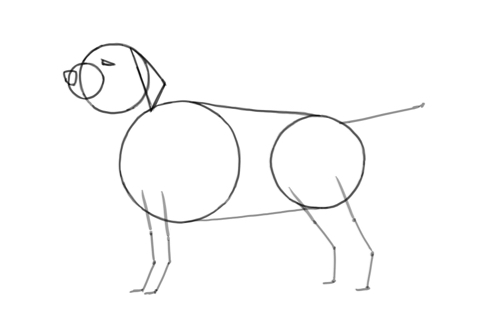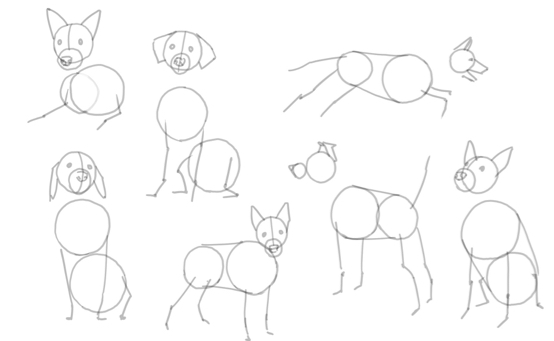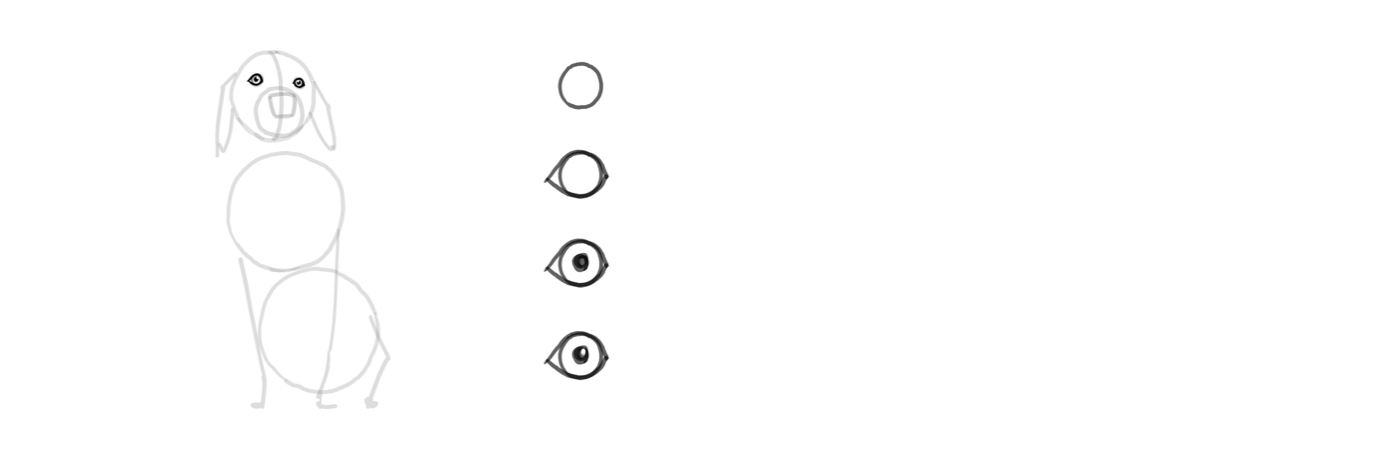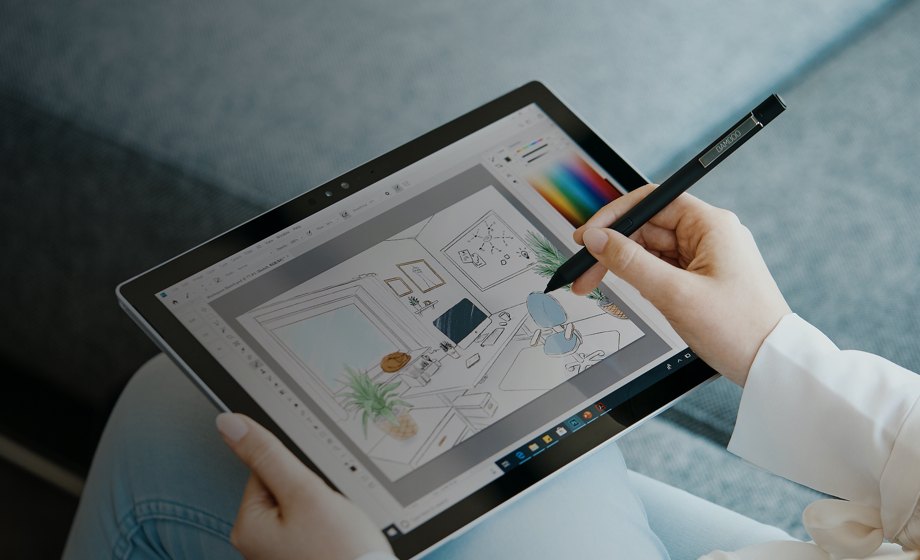Pen tablets
Esboza, dibuja y edita imágenes usando una tableta con gran capacidad de respuesta y un lápiz preciso, y observa cómo tus creaciones aparecen en pantalla.

Tanto si tienes un perro como si no, dibujar uno es sencillo cuando conoces los pasos adecuados.
En este tutorial aprenderás a dibujar un perro. Está dirigido a principiantes, pero incluso los artistas experimentados aprenderán un par de cosas. Veremos consejos para dibujar en una computadora o tableta, pero también puedes seguir estos pasos si dibujas con lápiz y papel.
Así que agarra lo que estés usando y empecemos…


Para entender la mejor manera de dibujar algo, siempre es útil reducir la imagen a algunas formas básicas. Acertar con el tamaño y la posición de estas formas ayuda a conseguir las proporciones correctas.
En el caso de un perro, podemos reducirlo a tres círculos. Los dos círculos de abajo formarán el cuerpo y el de arriba, la cara.

Añade otro círculo más pequeño al círculo superior para formar el hocico del perro. Luego, conecta los dos círculos inferiores para crear su cuerpo. Utiliza una línea para unir la parte superior de los círculos y otra para unir la parte inferior, como se muestra aquí.

Ahora es el momento de añadir las patas: dos procedentes del círculo delantero y dos del trasero. Es importante recordar que las proporciones de las patas de los perros son diferentes a las de los humanos. Utiliza la guía que aparece aquí para asegurarte de tener las articulaciones en la posición correcta. Asegúrate de que la posición de las patas sea correcta, que estén orientadas en la dirección correcta y que todas las articulaciones se doblen adecuadamente.
En esta fase también puedes añadir la cola. Simplemente dibuja una línea recta con un ligero ángulo hacia arriba desde la parte superior del círculo trasero.

Para formar la cara del perro debemos añadir la nariz, los ojos y las orejas. Como vamos a dibujar al perro de perfil, solo tienes que añadir uno de cada. Esboza el ojo utilizando una forma de V tumbada. Utiliza un triángulo para la oreja. Luego utiliza un círculo o un cuadrado para la nariz. Por ahora, lo más importante es conseguir que el tamaño y la posición de estos detalles sean correctos.

Ahora podemos empezar a perfilar el cuerpo y los rasgos del perro. Si utilizas papel, es mejor emplear un lápiz o un bolígrafo más oscuro y suave. Si utilizas un dispositivo digital, lo mejor es abrir una nueva capa de dibujo y suavizar los bocetos en los que has estado trabajando hasta ahora.
Puedes combinar dos técnicas diferentes para conseguir el mejor contorno. Para la parte superior del cuerpo, utiliza líneas normales. Luego, para crear un aspecto realista en la parte inferior, utiliza líneas de sombreado para que el pelaje no quede plano como en la parte superior.
Para la zona del pecho y el vientre, puedes seguir el círculo de tu boceto preliminar y ajustarlo ligeramente para conseguir la forma correcta del cuerpo. La frente, el hocico y la nariz pueden unirse para producir una forma continua. Luego, para añadir grosor a las patas, dibuja contornos a ambos lados de la línea matriz que dibujaste antes. Y recuerda: las patas tienden a ser más gruesas en la parte superior.

Todavía tenemos que dibujar el par de patas más alejadas. Los pares de patas parecen bastante idénticos en la vista lateral. Lo único que debes tener en cuenta es que los perros tienden a colocar las patas traseras un poco más separadas que las delanteras.
En esta fase también podemos desarrollar el hocico. No dudes en añadir una lengua babosa si quieres.


Siguiendo los pasos anteriores, puedes dibujar perros en todo tipo de poses. El primer paso es colocar los círculos correctamente. Con un poco de práctica, conseguirás encontrar las mejores proporciones y espaciado para ellos.

Como antes, presta atención a las articulaciones y a su alineación al dibujar las patas. Cuando dibujas el eje central de la cabeza, es más fácil determinar las posiciones correctas de los ojos y el hocico, especialmente si quieres representar al perro de medio perfil.

Por ahora, puedes indicar aproximadamente la posición de las fosas nasales en la nariz del perro. Más adelante entraremos en detalles al respecto.
La forma básica de la oreja de un perro es un triángulo, pero en determinadas posturas no funciona. Otras formas básicas son útiles como punto de partida, pero deberás ajustarlas en cada caso. Observa estos diversos métodos.
Ten en cuenta que las orejas de un perro son una parte esencial de su expresión. Las orejas erguidas sugieren alerta o incluso agresividad. Si quieres que tu perro esté relajado, debes dejar que las orejas cuelguen.

Para el estilo rápido y abocetado representado, puedes trazar el dibujo preliminar con los contornos y luego añadir el pelo con la ayuda de líneas rápidas en zigzag.
Dependiendo de la pose y la perspectiva, tendrás que variar la forma de dibujar las distintas partes del cuerpo, las protuberancias y hendiduras, los huesos, los músculos, las arrugas, etc. A menudo puedes encontrar los lugares adecuados utilizando tu imaginación. A veces es necesario examinar más de cerca la anatomía de un perro.
Aplicando los sencillos pasos aquí descritos puedes llegar bastante lejos en la mayoría de los casos. Como con cualquier sujeto, la mejor manera de captarlo con mayor precisión es dibujar directamente a partir de un modelo vivo.

Para la siguiente etapa dibujaremos un perro en pose relajada. Este perro se parecerá más a un golden retriever.

Los ojos de los perros son más circulares que los de los humanos. Así que empieza con un círculo y añade los párpados bastante cerca del círculo. En el centro del círculo, dibuja una pupila. Para el resplandor, añade un punto de luz ligeramente desplazado en la parte superior. Si utilizas un lápiz, piensa en el punto de luz antes de dibujar, o ten a mano una buena goma de borrar.

La nariz de un perro es una estructura bastante complicada, con algunas protuberancias y pliegues. He aquí un proceso sencillo para moldear la nariz del perro desde una perspectiva frontal:
1. Empieza con un cuadrado ancho, proporcionalmente como una hoja de papel A4 apaisada. Redúcelo a la mitad en altura y anchura. (En la mitad superior, la línea vertical bisectriz no es tan importante).
2. Coloca las fosas nasales en la línea central horizontal, cada una a la mitad del punto central. En los lados, haz una marca en ángulo hacia abajo a ¾ de distancia de la parte superior.
3. Redondea ligeramente los bordes.
4. Con la forma de caracol, une las marcas a ¾ de distancia con las fosas nasales. En la parte inferior, pon una V en el centro.
5. Une la V y la mitad superior con una línea curva. Las fosas nasales también se estrechan ligeramente hacia los lados a las 5 en punto (para la derecha) y a las 7 en punto (para la izquierda).
6. Elimina las líneas guía, excepto la vertical, que apunta hacia abajo desde el centro.

De frente, el hocico parece una W. En este dibujo, el perro mira ligeramente hacia la derecha, por lo que el lado derecho de la W debería ser un poco más estrecho que el izquierdo. La lengua sale directamente debajo de la W y cuelga sobre el labio inferior.

Para las patas, puedes empezar de nuevo con una forma básica. Esta vez utiliza un cuadrado ligeramente más ancho que para la nariz. Desplaza los bordes inferiores de los cuatro dedos muy ligeramente en altura para dar a las patas cierta profundidad. Luego puedes dar más definición a los dedos añadiendo espacios.

Ahora es el momento de convertir el dibujo preliminar en una forma continua. El cuello va directamente al cuerpo. Por debajo del cuello, los golden retriever tienen una especie de collar. En la parte superior de las patas delanteras hay hombros a ambos lados, que marcan la transición de la pata al cuerpo. Así que, en esta forma simplificada, usa esquinas sutiles en las líneas exteriores, más o menos a la altura del collar.
Por el momento, los contornos pueden seguir siendo líneas de unión suaves. Nos ayudan para el siguiente paso.

Al igual que antes con el perro de pie, puedes indicar el pelaje en los contornos con trazos rápidos de sombreado. Esto suaviza los bordes duros de los contornos y confiere al perro su esponjosidad.


Una de las ventajas de trabajar digitalmente es la enorme gama de tonos de color. Aquí hay muchos flujos de trabajo posibles, dependiendo del software y del artista. Una opción es trabajar con niveles de relleno para cada tono de color individual. Esto te brinda la oportunidad de ajustar y cambiar cada color al final.
Para este perro, necesitamos al menos seis tonos. Aquí tenemos cuatro tonos de marrón para el pelaje, un tono base, dos gradaciones más oscuras para el sombreado y una más clara para las zonas iluminadas. También podemos utilizar un tono rosa claro para la lengua y un tono marrón muy oscuro para los ojos, la nariz y la sombra que el hocico proyecta sobre la lengua.
No tienes por qué ceñirte a unos pocos tonos. Pero conviene empezar con una paleta de colores manejable y luego ampliarla cuando sea necesario.

Con el más claro de los dos marrones de sombreado, puedes definir aproximadamente algunas zonas de sombra. Intenta imaginar qué zonas están directamente iluminadas por la luz y cuáles están en sombra. Piensa también en si algunas partes del cuerpo proyectan sombras sobre otras zonas. En este caso supondremos que la luz viene de arriba, por lo que los bordes inferiores de las partes del cuerpo tienden a estar en la sombra.
También puedes resaltar un poco el hocico, los ojos y las mejillas, y en algunos lugares puedes hacer marcas de piel para el patrón del pelaje del perro.

Este perro tiene un pelaje suave, así que queremos lograr ese efecto en el dibujo. Para conseguir el efecto que se muestra aquí, suaviza el sombreado con un borde exterior de lápiz suave al 0 %. Si utilizas lápiz sobre papel, puedes emplear un difumino para esta técnica y conseguir un difuminado más preciso que con los dedos. El efecto del desenfoque es hacer que el tono básico del perro parezca lo más suave posible.

Bien, pasemos al tono marrón claro en los bordes superiores de las partes del cuerpo. Con los dos tonos marrones intensos (es decir, muy claro y muy oscuro) podemos crear la impresión de piel. Puedes construir un cepillo para pieles con este fin. Así, en lugar de una línea (es decir, muchos puntos pegados), dibuja muchos pelos al azar: más pequeños, más grandes o incluso ligeramente retorcidos. La mayoría de los programas gráficos ofrecen ajustes predeterminados de pinceles, pero tú también puedes crear un pincel como este con bastante facilidad. Lo único que debes hacer es pintar un solo pelo y ajustar la configuración. La alternativa es dibujar el pelaje mediante un hábil sombreado o dibujar muchos pelos.

Para conferir al perro un poco más de profundidad de color, trabaja las partes más oscuras con el tono marrón muy oscuro utilizando la técnica del pelaje anterior. Llegados a este punto, podrás saber si los tonos individuales se conjuntan bien. Si has trabajado con niveles de relleno, siempre puedes reajustar los tonos y las gradaciones.

Tu lindo y adorable perro ya está completo. Según tu estilo, puedes profundizar en los detalles. Puedes mantener un aspecto más abocetado o llevar el nivel de detalle hasta el fotorrealismo.
Espero que hayas disfrutado siguiendo este flujo de trabajo y dibujando a la vez. Siempre hay diferentes maneras de hacer un dibujo, así que sigue aportando tus propias ideas, pero tampoco dejes de buscar inspiración en los demás.
¡Diviértete dibujando y hasta pronto!
Wacom One crea una sensación familiar de lápiz sobre papel gracias a una pantalla de 13.3" con una superficie de fricción natural y un reflejo mínimo. El lápiz se siente ligero y natural en la mano, y se transforma en un lápiz, pincel o tiza en el software que elijas. Todo lo que necesitas para dibujar perros realistas. El software creativo viene incluido, junto con la capacidad de conectarse a tu computadora, así como a ciertos dispositivos Android.

Monitor interactivo Wacom One 13
Dibuja, diseña y crea directamente en una pantalla de alta resolución con un lápiz preciso.

Esboza, dibuja y edita imágenes usando una tableta con gran capacidad de respuesta y un lápiz preciso, y observa cómo tus creaciones aparecen en pantalla.

Dibuja, diseña y crea directamente en una pantalla de alta resolución con un lápiz preciso.


Escribe y anota rápidamente ideas en tu dispositivo móvil con un lápiz digital Wacom.
La estrategia de Wacom consiste en acercar la tecnología a las personas mediante su tecnología de interfaz que hace que la experiencia al usarlo se sienta natural. Esto ha convertido a Wacom en el fabricante líder a escala internacional de pen tablets y pantallas interactivas, así como de lápices digitales y soluciones para guardar y procesar firmas digitales. La tecnología avanzada de los dispositivos Wacom es Intuitiva y se ha utilizado en la creación de algunas de las películas, efectos especiales, moda, diseños y obras de arte digitales más interesantes del mundo, y ofrece a los usuarios domésticos y profesionales una tecnología de interfaz líder para expresar su propia personalidad. Fundada en 1983, Wacom es una compañía global con sede en Japón (bolsa de valores de Tokio: 6727), con filiales y sucursales en todo el mundo para cubrir operaciones de marketing y distribución en más de 150 países.